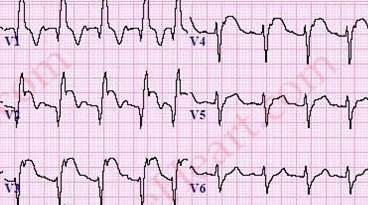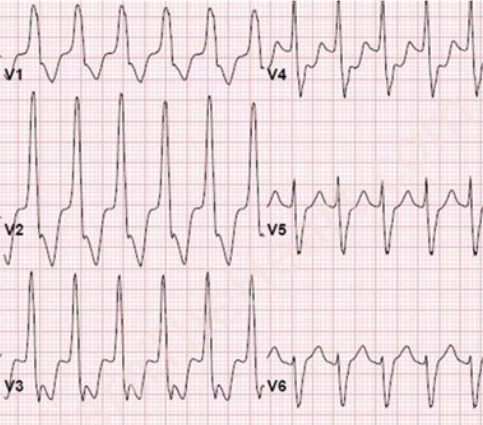ECG Reviews
Right Bundle Branch Block (RBBB) ECG Review
The ECG criteria for a right bundle branch block include the following:
- QRS duration greater than 120 milliseconds
- rsR’ “bunny ear” pattern in the anterior precordial leads (leads V1-V3)
- Slurred S waves in leads I, aVL and frequently V5 and V6
Remember that T wave inversions and ST segment depression are normal in leads V1 to V3 in the presence of a right bundle branch block; thus, myocardial ischemia technically cannot be easily determined in these leads. However, unlike in the presence of a left bundle branch block, myocardial ischemia and infarction can easily be detected on ECG when a RBBB is present.
Below is an ECG displaying a right bundle branch block with an anterior ST segment elevation MI, followed by some other examples.
- Anterior Wall ST Segment Elevation Myocardial Infarction (MI) with RBBB ECG (Example 1)
- Anterior Wall ST Segment Elevation Myocardial Infarction (MI) with RBBB ECG (Example 2)
- Inferior Wall Myocardial Infarction (MI) with RBBB ECG (Example 1)
- Inferior Wall Myocardial Infarction (MI) with RBBB ECG (Example 2)
Some variations of right bundle branch blocks can occur. There are times when a QRS complex may appear in a RBBB pattern intermittently. This is the case in premature ventricular contractions that arise from the left ventricle, which take time to travel to the right ventricle, thereby resulting in a RBBB QRS morphology. This may also occur in the setting of an Ashman beat, a premature atrial contraction or supraventricular beat that occurrs when the right bundle is refractory, causing the beat to conduct with a RBBB pattern. Here is an example:
A typical “bunny ear” pattern is not always present in a RBBB, as the R or the R’ may be very small; therefore, do not rely on identifying “bunny ears” to diagnose a RBBB. Here is an example of a QRS complex with a RBBB pattern, but without the typical rsR’ pattern:
A “rate-dependent” right bundle branch block can also occur during times of fast heart rate. When the heart rate slows, the narrow QRS complex returns. A rate-dependent RBBB can, at times, be mistaken for ventricular tachycardia. The Brugada Criteria can be helpful in distinguishing these two entities.
Lastly, VT itself can sometimes have a RBBB pattern if it arises from the left ventricle. If tachycardia is present — that is, heart rate greater than 100 beats per minute — in a RBBB pattern, VT should be considered.
The QRS morphology criteria to diagnose VT with a RBBB include the following:
- A monophasic R or biphasic qR complex in V1
- An RSR’ or “bunny ear” pattern present in V1 or V2, with the R peak higher in amplitude than the R’ peak (see image below)
- A rS complex in lead V6 (favors VT)
ECG Examples:
- Incomplete Right Bundle Branch Block (RBBB) ECG (Example 1)
- Incomplete Right Bundle Branch Block (RBBB) ECG (Example 2)
- Monomorphic Sustained Ventricular Tachycardia ECG (Example 3)
- Rate-Dependent Right Bundle Branch (RBBB) Block ECG
- Right Bundle Branch Block (RBBB) ECG (Example 1)
- Right Bundle Branch Block (RBBB) ECG (Example 2)
- Right Bundle Branch Block (RBBB) ECG (Example 3)
- Right Bundle Branch Block (RBBB) ECG (Example 4)
- Right Bundle Branch Block (RBBB) ECG (Example 5)
- Right Bundle Branch Block (RBBB) ECG (Example 6)
- Right Bundle Branch Block (RBBB) ECG (Example 7)
References:
1. Chou’s Electrocardiography in Clinical Practice: Adult and Pediatric, 6e
2. Surawicz B, et al. AHA/ACCF/HRS Recommendations for the Standardization and Interpretation of the Electrocardiogram. Circulation. 2009;doi:10.1161/CIRCULATIONAHA.108.191095.





